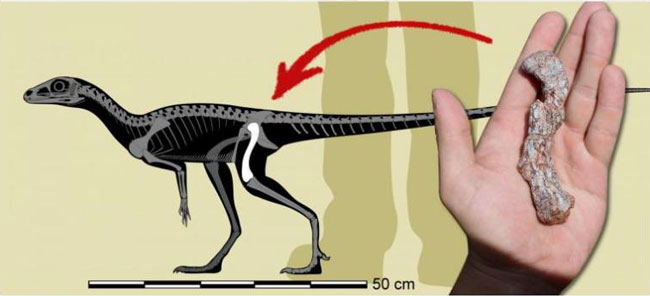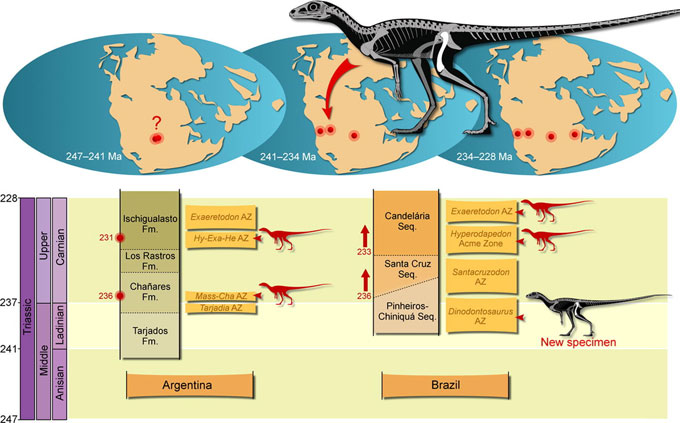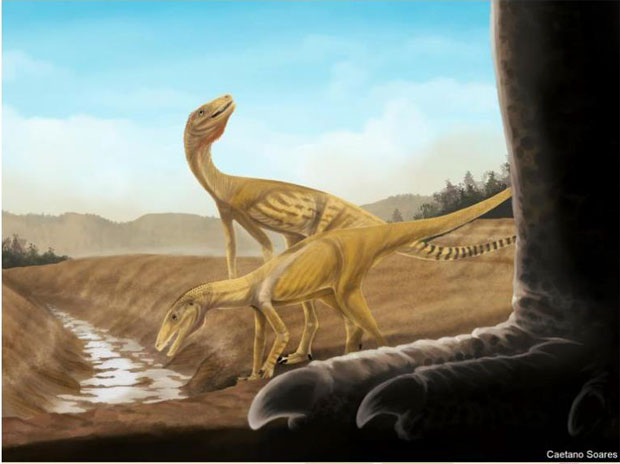The debate continues as to when the first dinosaurs evolved. Some of the oldest specimens described to date come from the famous Ischigualasto Formation located in north-western Argentina. These sediments are estimated to be around 232 million years old. It is thought that the first true dinosaurs evolved in the Southern Hemisphere and many palaeontologists favour a South American origin whilst others consider the evolutionary cradle of the Dinosauria was Africa: Dinosaurs Out of Africa?
To compound this debate, the fossil record of the ancestors of dinosaurs is particularly sparse. Some older Argentinian deposits have provided evidence of the precursors to the “true dinosaurs”, with some of these fossils estimated to be around 236 million years of age. However, scientists from the Universidade Federal de Santa Maria (Rio Grande do Sul, Brazil), have reported the discovery of a single fossilised thigh bone from Middle Triassic sediments in Brazil that predates all the Argentinian dinosauromorph fossils.

A skeletal drawing showing the placement of the right femur bone (shown in white) and a photograph of the actual fossil. Skeletal drawing by Maurício Silva Garcia, photography by Rodrigo Temp Müller. Note scale bar = 50 cm.
Picture credit: Maurício Silva Garcia/Rodrigo Temp Müller
The Dinodontosaurus Assemblage Zone
The fossilised thigh bone (right femur) measures 11 cm in length and it comes from Middle Triassic sediments (Pinheiros-Chiniquá Sequence) from the famous Dinodontosaurus Assemblage Zone, so named because as well as archosaur fossils, the sediments have yielded an abundance of fossil material associated with the dicynodont Dinodontosaurus. The femur has a morphology similar to the thigh bones of other dinosauromorphs, but it comes from much older stratum, estimated to be at least 237 million years old (Ladinian faunal stage of the Middle Triassic).
This newly described specimen establishes that the Dinosauromorpha (dinosaurs and their close ancestors), were present in South America earlier than previously recorded and extends the fossil record of South American dinosauromorphs into the Ladinian stage of the Triassic.
The thigh bone might be small and no genus has been erected based on this single fossil, but it does represent the oldest dinosauromorph fossil found in South America to date.

A skeletal drawing of the Brazilian dinosauromorph (femur shown in white) with a comparison of fossil specimen stratigraphy from Argentina and Brazil which demonstrates the thigh bone represents the oldest evidence of Dinosauromorpha described to date in South America. Picture credit: Müller and Garcia.
Picture credit: Müller and Garcia
An Ecosystem Dominated by Other Reptiles
Based on comparisons with more complete fossil specimens the femur came from an animal around a metre in length, most of which was accounted for by its long, thin tail if this dinosauromorph possessed a similar body plan. It lived in a diverse ecosystem dominated by other types of reptile. For example, the giant pseudosuchian Prestosuchus was probably the apex predator and at nearly 7 metres in length, this giant member of the crocodile-line of the Archosauria would have dwarfed all the dinosauromorphs in the ecosystem.

A life reconstruction of the Brazilian dinosauromorph based on the 11 cm long femur. This ancestor of the Dinosauria would have been dwarfed by other archosaurs in the ancient environment (Prestosuchus). Picture credit: Caetano Soares.
Picture credit: Caetano Soares
For an update on the research into South American dinosauromorphs: A New Silesaurid from South America.

A scale drawing showing the relative sizes of the Brazilian dinosauromorph from the Pinheiros-Chiniquá Sequence compared to Prestosuchus chiniquensis. Picture credit: Everything Dinosaur.
Picture credit: Everything Dinosaur
The scientific paper: “Oldest dinosauromorph from South America and the early radiation of dinosaur precursors in Gondwana” by Rodrigo T. Müller and Maurício S. Garcia published in Gondwana Research.
Visit the Everything Dinosaur website: Prehistoric Animal Models.






Leave A Comment